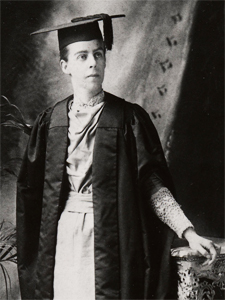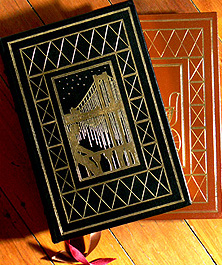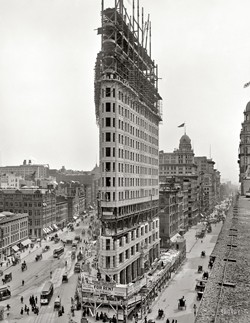View Part One, Part Two, and Part Three of the Education of Sara Howard series.
Today’s final installment in the Education of Sara Howard series moves beyond our hypothetical Sara’s college years to focus on the career choices a young woman of Sara’s social class in New York had available to her in the 1880s and 1890s. As indicated at the conclusion of Part Two, the life choices female college graduates faced in the years immediately following college during the late 19th century could be stressful, with many young women forced to make difficult choices between the family claim and the social claim, the choice between marriage and a career, and the limited number of professions open to women if they did decide to pursue a career. However, a determined minority — of which Sara was one — pushed beyond societal expectations and made choices women earlier in the century would never have dared dream about. These college graduates were known collectively, in America and abroad, as “the new women”, and this is their story.
The Post-College Years
In 1896, a manual for young women was published that discussed common problems faced by female college graduates in America. Entitled “After College, What?“, the manual explained that most young women faced a “blank nothingness” at the conclusion of their college degree that left them feeling a “deep and perplexing unhappiness” until they either got married or were able to find “something [useful] to do”. Having spent four years immersed in an environment that fostered the development of independence and autonomy that was not encouraged in the typical patriarchal family home, these young women completed their college degree with a yearning to go out into the world at large and fulfill their “social claim” — a calling to use their advanced education in the same way that their brothers could; as an independent citizen with a role beyond that of wife and mother. However, upon returning to the family home following graduation, the majority of women found their parents in direct opposition, asserting the “family claim”.
 Although these middle- and upper-class families had permitted — and even encouraged — their daughter to pursue self-improvement in the form of advanced education, by the time their daughter reached her early-to-mid-20s, she was expected to turn her attention to domestic responsibilities, devoting herself to taking care of parents and siblings until she could find a suitable husband, and filling any spare hours with charity work and sewing circles. For many young women who had for the first time started to think of a world beyond the home being made possible by her four years away at college, these conditions were stifling. Their girlhood friends who saw marriage as the only possible step once they returned from finishing schools, trips abroad to the continent, and formal debuts, did not want to mix with the young college graduate “whose aims were so different from their own”, and the college women faced “what was almost social ostracism”. One young graduate lamented, “We college girls are made to feel that we are different, we feel our separation.” Another, Marion Talbot, who would eventually become Dean of Women at the University of Chicago in 1895 recalled of her own difficult years immediately post-college in the early 1880s, “Here, then, was Marion Talbot with a college degree and an absorbing desire to make herself and her education useful, but with as barren an outlook for such a future as one can imagine.”
Although these middle- and upper-class families had permitted — and even encouraged — their daughter to pursue self-improvement in the form of advanced education, by the time their daughter reached her early-to-mid-20s, she was expected to turn her attention to domestic responsibilities, devoting herself to taking care of parents and siblings until she could find a suitable husband, and filling any spare hours with charity work and sewing circles. For many young women who had for the first time started to think of a world beyond the home being made possible by her four years away at college, these conditions were stifling. Their girlhood friends who saw marriage as the only possible step once they returned from finishing schools, trips abroad to the continent, and formal debuts, did not want to mix with the young college graduate “whose aims were so different from their own”, and the college women faced “what was almost social ostracism”. One young graduate lamented, “We college girls are made to feel that we are different, we feel our separation.” Another, Marion Talbot, who would eventually become Dean of Women at the University of Chicago in 1895 recalled of her own difficult years immediately post-college in the early 1880s, “Here, then, was Marion Talbot with a college degree and an absorbing desire to make herself and her education useful, but with as barren an outlook for such a future as one can imagine.”
However, not all parents during this period were unsupportive or asserted the family claim. As a result of her daughter’s negative experiences, Marion Talbot’s mother founded the Association of Collegiate Alumnae in 1882 for graduates from Oberlin, Vassar, Smith, and Wellesley Colleges, and Michigan, Wisconsin, Cornell, and Boston Universities to provide support that young women often lacked following graduation, and to help them through the anxiety and depression that frequently resulted from their feelings of isolation. In another example, Hilda Worthington Smith’s mother encouraged her daughter to volunteer for mission work following her graduation from Bryn Mawr College in 1910 as she felt that life as a homemaker was “too much to ask” of Hilda, and she went on to encourage her daughter to find a paying position a few years later. On the subject of her mother’s atypically supportive attitude toward entering the workforce, Hilda commented:
This I knew was a great concession, as several of her friends had warned her against letting me venture into the untried world of women’s work. Those women who did it were still thought very “advanced.” Any such excursions from home might lead to a daughter wanting her own apartment and becoming alienated from her family.
Mrs. Smith’s “advanced” views served her daughter well. Hilda went on to become Acting Dean and Dean of Bryn Mawr College from 1919 until 1922, and then Director of Bryn Mawr Summer School for Women Workers from 1921 until 1933. Fortunately for the clever and independent Sara, it appears as though her parents views were as similarly “advanced” as Hilda’s mother’s, which we get a glimpse of in The Alienist, 78, when John Moore relates one of her post-college activities:
…right after Sara’s graduation from college, her family had gotten the idea that her education might be fully balanced by some firsthand experience of life in places other than Rhinebeck (where the Howards’ country estate was located) and Gramercy Park. So she put on a starched white blouse, a dreary black skirt, and a rather ridiculous boater and spent the summer assisting a visiting nurse in the Tenth Ward.
However, perhaps the most important thing to note, regardless of how supportive or unsupportive families were, is that for almost all of the young women who belonged to the pioneering generation of female college graduates in the late 19th century, parental attitudes and family ties were the key factor in the decisions they made about what to do following graduation. Although there were rare college graduates who decided to find a means of supporting themselves in order to live completely independently immediately following graduating in order to avoid the need to consider the family claim at all, these women were the exception rather than the rule — and given her supportive family and the influence they had on her decision to gain firsthand experience as a visiting nurse in the Tenth Ward, it seems safe to say that Sara would not have been one of them. | Continue reading →
 With the holiday shopping season upon us, I thought it might be worth drawing attention to the signed leather bound edition of The Alienist currently available through Easton Press for the book collectors amongst us. This edition forms part of the Easton Press “Signed Modern Classics” collection. Unfortunately, I have only been able to find one image of the binding for this edition online, and I’m not sure what year it was released. While most catalogues indicate that it was released in 2007 or 2008, an Easton Press collector stated on a forum post dated early 2011 that it had not, in fact, been released in either of those years. Combined with Easton Press’ usage of the most recent publicity photo of Caleb Carr from 2012, this seems to hint that the release date may have been considerably later than those indicated on catalogues — perhaps even 2012 or 2013? Mysterious release date aside, this edition is advertised as being personally signed by Caleb Carr and can be purchased directly from Easton Press. Reasonably priced at $89, what better surprise could you get for a fan of The Alienist this Christmas?
With the holiday shopping season upon us, I thought it might be worth drawing attention to the signed leather bound edition of The Alienist currently available through Easton Press for the book collectors amongst us. This edition forms part of the Easton Press “Signed Modern Classics” collection. Unfortunately, I have only been able to find one image of the binding for this edition online, and I’m not sure what year it was released. While most catalogues indicate that it was released in 2007 or 2008, an Easton Press collector stated on a forum post dated early 2011 that it had not, in fact, been released in either of those years. Combined with Easton Press’ usage of the most recent publicity photo of Caleb Carr from 2012, this seems to hint that the release date may have been considerably later than those indicated on catalogues — perhaps even 2012 or 2013? Mysterious release date aside, this edition is advertised as being personally signed by Caleb Carr and can be purchased directly from Easton Press. Reasonably priced at $89, what better surprise could you get for a fan of The Alienist this Christmas?


